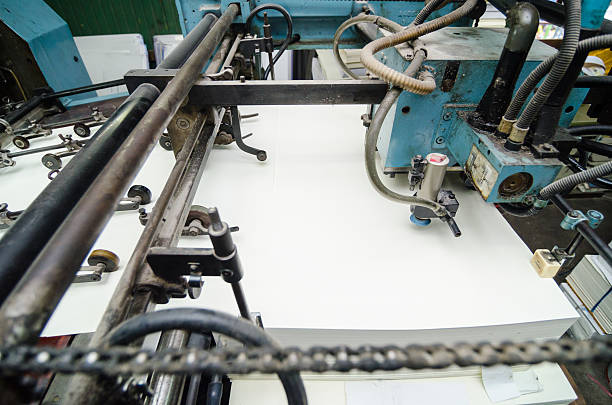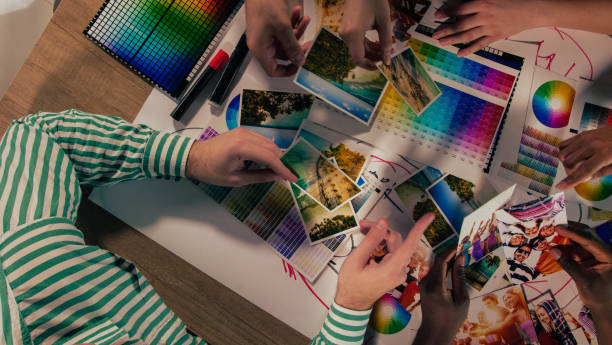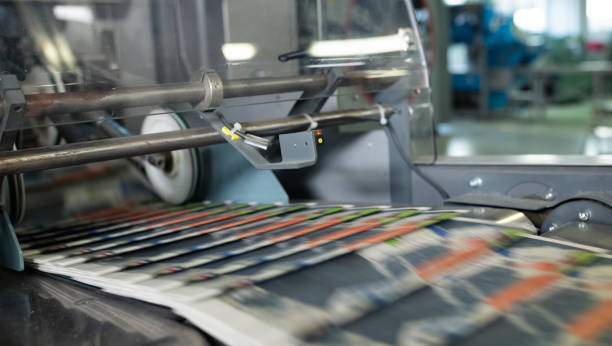
The world of zine printing has bloomed, embraced by independent creators for self-expression. Originally from the punk scene, zines cover topics from personal stories to social issues. Zine makers in Australia and around the world are finding new ways to share through both print and online.
This guide will lead you through the zine-making journey. You could be new or experienced, we’ll look at marketing strategies for your projects. We’ll discuss making attractive covers and using print-on-demand services. Additionally, using a local print shop can be a convenient and cost-effective option for printing zines. MVP Print can help get your zine to readers.
Exploring zine distribution is next. We’ll cover local spots and online places, attracting readers globally. Digital publishing has made it easier to distribute zines without big costs upfront.
Ready to explore the exciting zine world? Let’s see how you can make something that readers in Australia and beyond will love. We’ll turn your ideas into something real and sharable.
Understanding Zine Culture and Its Resurgence
Zine culture comes from DIY and underground art. These magazines are made by people themselves. They express creativity in many areas, like fanfiction and politics, art, and social ideas. Zines have been around since the early 20th century.
The history of Zine Printing and DIY publishing
Zines started in the 1920s, growing from sci-fi fanzines. The 1970s punk movement helped photo zine production spread, especially those about bands not in the mainstream. Third-Wave Feminism used zines to talk about issues like sexuality and body image.
- Science fiction fanzines were among the earliest incarnations
- The first media fanzine, Spockanalia, was released in 1967
- Horror and comics fanzines emerged as alternatives to mainstream publications
Why Zine Printing remains popular in the digital age
Zines have become more popular in the past decade. They let creators from various backgrounds share their work. Zines are often printed in small numbers, sometimes no more than 100 copies. Despite the digital age, zines are still valued for their uniqueness. In European countries and Australia, the most common zine sizes are 210 mm x 297 mm and 148 mm x 210 mm. “Zines serve as a method of expression and communication for marginalized communities.”
The role of zines in contemporary art and subcultures
Zines are important in art and subcultures today. They give a voice to those who are often not heard, like LGBT individuals and women. Generation Z, the young people today, are into zine culture. They use it to talk about important subjects and share poetry. Local places like libraries and bookstores support zine-making.
Zines are still loved because they challenge the usual thinking. They offer fresh views on many topics, from politics to sci-fi. This makes them key in the world of DIY and alternative art.
Identifying Your Target Audience for Zine Printing Distribution
Finding your zine’s audience is a key step for success. Zines are often for specific groups, so knowing what they like is crucial. This makes sure your zine appeals to the right people.
Think about what your zine is all about. Is it about Aussie indie music, saving the planet, or local art? Those who love what you write about will be your main readers.
When picking your readership, think about things like:
- Age group
- Cultural background
- Shared interests or hobbies
- Geographic location
Zines are great at bringing people together. Go to events, local shops, and chat in online spaces. This will help you know your readers better.
Zines mainly catch the eye of younger people. They enjoy something physical in a mostly digital world.
“Zines serve as a platform for self-expression, creativity, and sharing unique ideas with the world.”
Owning a niche can lead to a big fan base. Whether it’s about Aussie street art or tasty vegan food, dedicated readers will love it.
Knowing who will read your zine will help you share it in the right places. Think about spots like music gigs, cool bookstores, or even work offices.
Making your zine match your readers’ interests is key. This way, you can build a strong community. Plus, you could even make money from your zine down the track.
Crafting a Compelling Zine Concept and Design

Creating a zine is all about expressing yourself and using your creativity. The great thing about zines is that anyone can make one. You don’t need anyone’s permission. This has helped many people whose voices are often ignored, to be heard. Zines are also a way to question what most people think.
Choosing a theme or topic for your Zine Printing
When picking a topic for your zine, choose something that really matters to you. This could be about your own life or something you strongly believe in. Some ideas include:
- Subverting dominant ideologies
- Sharing recipes with illustrations
- Showcasing mini-comics or sketches
- Exploring niche interests or subcultures
Incorporating visual elements and layout techniques
Zines love unique looks and creative layouts. Use a mix of words, pictures, and different feels. You can start with a template but don’t feel like you have to stick to it exactly.
If you’re making your zine digitally, work with pages that are 850 by 1100 pixels in size. Use programs that let you work in pixels. Save your pages as JPEGs or PNGs when you’re done.
Selecting appropriate paper and binding options for perfect bound zines
The kind of paper and how you bind your zine really affects how it turns out. Here are some common ways:
- Folded sheets for a simple, classic look
- Stapled versions for a more substantial feel
- Hand-sewn binding for a crafty, personalised touch. Perfect binding is recommended for zines with heavier interior paper or a page count exceeding 48 pages.
Remember, you can print your zine locally or online. Thicker paper can make a zine feel heavier and more luxurious, and it is often recommended for zines that include photography and full-color artwork. But, always do a test print to make sure everything’s lined up right. “Zines are a canvas for your imagination. Let your creativity run wild and don’t be afraid to experiment with different formats and styles.” To make your zine stand out, focus on a cool concept. Mix in interesting visuals. Choose good paper and binding. This will make a zine that really connects with people. So, go ahead and have fun creating your zine!
Zine Printing: Methods and Considerations

Custom Zine printing allows creators to make their dream projects real. They can choose from DIY techniques to professional printing. What you pick can change how your zine looks and feels.
DIY vs Professional Zine Printing Services
DIY printing, like photocopying or printing at home, lets zine makers control everything. It’s cheap and fast. On the other hand, professional printing, such as at MVP Print, gives a better finish and quality. Additionally, using online printers offers convenience, cost-effectiveness, and various options such as different paper weights, finishes, and binding methods.
But, always do a test print to make sure everything’s lined up right. It’s crucial to prepare files to be print-ready, considering factors such as bleed zones, safety areas, trim lines, resolution, and color space.
Digital printing vs Offset Printing for Zine Printing
In professional printing, digital and offset are the choices. Digital works well for small orders, giving fast prints in vivid colours. Offset shines with larger orders, offering detailed quality and consistent colours.
- Digital printing: Fast, flexible, great for small printed zine runs
- Offset printing: High-quality, cost-effective for large runs, more paper options
Cost-effective Strategies for Zine Printing
Here are some tips to make zine printing savings:
- Pick the right zine printing service for your order size
- Use standard paper sizes to lessen waste
- Go for black and white printing inside
- Look into bulk printing for saving money in the long term
- Most Zines are most cost-effective hen using an online printer.
Ensure that the page count is divisible by four, as this affects the pricing and different binding options available for your zine.
Choosing between digital and offset depends on what you want and how many prints you need. MVP Print can help you choose wisely for the best cost and quality mix. “Zine printing empowers artists to share their unique perspectives and stories directly with their audience.” Learning about printing options helps you match your creative dreams and budget. Whether you’re printing a few or a lot, there’s a good choice for your zine.
Building a Brand Identity for Your Zine
Creating a strong brand identity is key in the world of indie zines. A well-crafted brand makes your zine stand out. It can draw in loyal readers. We’ll look into making a unique brand for your zine.
Start by making a logo for your zine’s brand. This logo will be your brand’s face. It should be easy to remember and show what your zine is about. When designing your logo, think about these points:
- Use colours that connect with your readers
- Keep it simple and easy to recognise
- Make sure it looks good in all sizes and mediums
Then, focus on keeping a common look in your zine. Choose a set of colours, fonts, and layout that match your brand. An example is the Newspaper Club, who worked with D8 to make a strong, consistent look, with eye-catching zine covers.
It’s also vital to plan your content. Your writing and voice should match your zine’s personality and connect with your readers. Think about making a style guide to keep your content on track.
“A well-crafted brand identity can elevate your zine from a passion project to a recognizable publication.”
Create a zine with brand guidelines to lock in your identity. This resource helps keep your team and partners on the same page. It should cover:
- Brand history and core values
- Logo use and designs
- Fonts and colours
- Images and graphics style
- Writing style and voice
Don’t forget, your brand should change and grow with your zine. Updating your guidelines regularly will keep them useful for your zine’s success.
Leveraging Social Media for Zine Promotion

Social media is vital for getting your zine out there and reaching readers. We’ll show you how to make the most of top platforms.
Utilising Instagram, Twitter, and TikTok for zine marketing
Every social media site brings different chances for zine promotion:
- Instagram: Post eye-catching zine sections, behind-the-scenes looks, and what readers say.
- Twitter: Send out brief updates, chat with followers, and dive into zine topics.
- TikTok: Have fun with short videos, revealing how you make your zine and what’s inside.
Creating engaging content to showcase your zine
To really get noticed, focus on making diverse, cool content:
- Put up top-notch zine pictures and cover art.
- Share pieces of written work to get people interested.
- Do time-lapses of your zine-creating.
- Have live Q&A’s with your followers for a chat.
Building an online community around your zine
Creating a digital community is crucial for your zine’s long-lasting success. Here are some moves to try:
- Use the right hashtags to be seen and meet similar creators.
- Work with other zine creators and artists to help each other out.
- Be quick to answer comments and messages to stay in touch with your followers.
- Set up online zine making or reading events to unite your community.
Don’t forget, keeping up with posting and being involved is key. It will grow your online world and make your zine more visible.
“Social media has changed zine sharing. It’s now simpler to reach readers and creators from all over.”
Exploring Traditional Distribution Channels for Zine Printing
Zines have a deep history in Australia’s underground scene. They give space for personal expression and unique hobbies. Even with the rise of digital trends, old ways of getting zines out are still crucial.
Indie bookstores are a hidden gem for zine fans. They often set aside special areas for indie releases. It’s great to check these spots and see if your zine fits. You might find a good sale or consignment deal.
Zine libraries are key for spreading your work. They love offering various zines and let readers explore different styles. Try giving copies of your zine to zine libraries nearby. It’s a great way to grow your audience.
Art galleries, especially the offbeat ones, can also help. They sometimes offer zine shows or places to sell them next to art. This blend of zines and art introduces your work to a wider group.
Look into local places that focus on specific interests. Stores that sell vinyl, comics, or unique clothes are usually keen on zines. Making friends with these shopkeepers can lead to good deals for you both.
- Attend zine fairs and art markets to sell directly to enthusiasts
- Establish connections with distributors specialising in independent publications
- Leverage your personal network for word-of-mouth promotion
- Consider collaborating with other zine makers for shared distribution
“Zines are about creating connections and sharing ideas. Traditional distribution channels help foster these connections in tangible ways.”
Exploring these age-old channels can set a solid base for distributing your zine. The zine scene is all about personal links and mutual interests. Keeping these principles in mind will guide you well in the Australian zine world.
Utilising Online Platforms for Zine Sales and Distribution
The digital age has opened new doors for zine makers worldwide. It’s now simpler than ever to sell and distribute zines to a global market. Using e-commerce platforms and print-on-demand services is key.
Setting up an Etsy shop or personal website
For zine creators, Etsy is a valuable platform. It’s easy to use and attracts people looking for unique, handmade goods. Setting up shop on Etsy involves:
- Choosing an eye-catching name for your shop
- Adding clear, high-quality images of your zines
- Writing detailed descriptions about your zines
- Setting fair prices for your products
- Providing various shipping choices for buyers
Creating your own website gives you more brand control. It’s excellent for featuring your work and forming direct reader connections.
Using print-on-demand services for zine fulfilment

Services like MVP Print are great for zine makers. They handle production and shipping after receiving an order. This means no need for big upfront investments or space for storing zines. Their advantages include:
- No minimum order quantities
- A wide variety of paper and binding options to choose from
- Customers can request special paper not listed in the dropdown menu for their internal pages
- The ability to distribute zines globally
- Integration with various e-commerce platforms, making selling easier
Exploring digital zine distribution options
Going digital is an effective way to reach more people while cutting costs. Some digital distribution options comprise:
- Offering zines as PDF downloads on your website or through services like Gumroad
- Adapting zines into e-book formats for Kindle and other e-readers
- Using online flipbooks for a more interactive reader experience
Research shows that 70% of smartphone users in the UK read digital magazines. For zine makers, this means a big chance to connect with readers. Digital zines are easy to share, update, and keep track of via analytics.
Digital magazines provide analytics insights that offer a deeper understanding of reader engagement.
By using these online and digital tools, a zine maker can create a strong plan for reaching a broad audience. This allows more people to discover and enjoy your zines.
Collaborating with Other Zine Makers and Artists
The zine community is all about coming together and working with others. By teaming up with fellow zine makers and artists, you can breathe life into your work. It also helps you to get your work out to more people. Here’s how to get the best out of these partnerships.
Gimmie zine’s success story proves how great collaborating can be. They linked up with creative folks everywhere, making their content super diverse. In six months, they did over 100 interviews. This helped spread their work a lot.
In the world of zines, working together is a key move. Take Magnetic Visions for example. They talk to cool artists like Alien Nosejob and Lassie in their zine. By doing this, they get to share fans, helping everyone involved.
There are lots of ways to work together on your zine projects:
- Organizing zine swaps in your community or online.
- Creating special issues with guest artists or writers.
- Writing for someone else’s zine.
- Teaching others your skills through workshops or online guides.
Working together can also make zine-making cheaper. Colour printing, for example, can be pricey, as noted by Billy from Magnetic Visions. By sharing costs with other zine makers, you might be able to print more, or print in higher quality.
In the zine world, it’s all about sharing and helping each other. For Billy, discovering Negative Guest List zine was the push he needed to start making zines. Your teamwork could inspire the next wave of zine creators!
“Zines are a powerful tool for sharing personal stories and creating tangible representations of one’s experiences.”
When you work together and connect in the zine world, you do more than just spread your work. You also support an entire community of indie publications. So go ahead, reach out, and put your heart into collaborating on your zine creations.
Participating in Zine Fairs and Art Markets
Zine fairs and art markets are great chances to show your art and meet other creators. These events are big in Australia, making it easy for zine makers to connect with fans.
Finding and applying to zine events in Australia
In Australia, there are many cool zine fairs and art markets. The Festival of the Photocopier and Melbourne Art Book Fair really stand out. People from all over the country come to these events. Photo zines are one of the potential options for content, along with examples like poetry zine, comic, collage zine, etc.
- Festival of the Photocopier: Held annually in Melbourne, this event celebrates DIY publishing.
- Melbourne Art Book Fair: A major platform for independent publishers and artists.
- Other Worlds Zine Fair: Taking place in Sydney, this fair focuses on alternative and radical publications.
To join in, look for events and apply early. Each fair might have its own rules for those who want a stall. Be sure to check those out before making your move.
Preparing your booth display for maximum impact
Your booth’s look is key in pulling people in. Make it stand out and match your zine’s vibe. Here are some ideas to get you started:
- Use vertical displays to maximise limited table space
- Incorporate props or decorations that complement your zine’s aesthetic
- Ensure your pricing is clear and visible
- Bring a variety of your work to cater to different interests
Networking and building relationships at zine fairs
Zine fairs are more than just for selling. They’re prime spots for meeting others in the community. Remember to bring your business cards and info to swap with people you meet.
“Zine fairs are the heart of our community. They’re where we share ideas, find inspiration, and forge lasting connections.”
These events are great for making connections that could lead to future projects. Stay open to getting to know new people and their work. The zine community is friendly and supportive, especially to those who share its passion.
Conclusion
Learning how to market and distribute your zines well is key to making it in Australia’s zine world. Since the 70s, zines have gone from the punk scene to modern times with their special appeal still intact. No matter if it’s a small A5 zine or a big book, it’s a chance to show what matters to you.
Make the most of old and new ways to share your zine. Go to zine fairs, team up with other creators, and use social media to get your zine noticed. Zines are more than just selling; they’re about telling stories and making friends. You can create anything from basic 40-page zines to fancy 400-page books, depending on your dream. Perfect bound zines have a zingy appearance, are durable, easy to store, and cheap to mail out.
Starting your zine adventure means mixing your love with a plan. Focus on making great stuff, picking the best way to print, and talking to your readers. Whether you choose a simple saddle-stitch or a luxurious PUR binding, your zine shows that putting your thoughts on paper is always powerful. Using a print shop for high-quality printing offers technical capabilities and cost-effectiveness for both small and large print runs.








